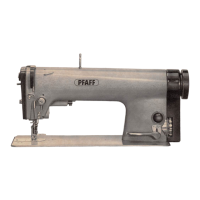34.
Zeroing
the
Top
and
Bottom
Feeds
Set
stitch length control n on 0 (Fig,
16).
Then rotate
the
balance
wheel and
check
to
see
that
the
vibrating presser
and
the
feed dog make no perceptible motion in
the
direction of
sewing.
If the feed dog should make any lengthwise motion, eliminate this motion by turning the
upper
feed regulating shaft. To do this, seize hexagon nut SR (Fig. 41) at
the
right-hand
end
of
the
shaft
(which
serves
to
tension
torsion
spring
DU)
with
a
SW
22
wrench
and
loosen
binding screw Km on the ball-end clamp crank. Adjust the upper feed regulating shaft with
a
wrench
while turning
the
balance
wheel until
the
feed dog makes no motion at alt.
Fig. 41
B
R
9483
Then
tighten
binding
screw
Km
on
the
clamp
crank.
Set
stitch
length
control
n on
4.5
and
turn
out
regulating
screw
B
completely.
Then
turn
in
regulating
screw
A until
bar
Ba
contacts
the
upper
feed
regulating
shaft.
As
you
make
this
adjustment,
make
sure
the
ball
end
remains
In
engagement
in
the
slot
of
stitch
length
control
n.
This
means
that
regulating
screw
A
must
be
turned
in
only
far
enough
to
cause
bar
Ba
to
contact
the
upper
feed
regulating
shaft
lightly.
Turning
screw
A in
too
far
would
disturb
the
setting
of
the
upper
feed
regulating
shaft
which
controls
the
drop
feed
motion.
43

